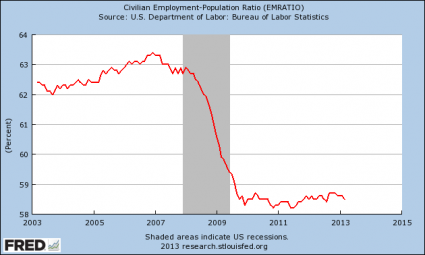 The jobs recovery is a complete and total myth. The percentage of the working age population in the United States that had a job in March 2013 was exactly the same as it was all the way back in March 2010. In addition, as you will see below, there are now more than 101 million working age Americans that do not have a job. But even though the employment level in the United States has consistently remained very low over the past three years, the Obama administration keeps telling us that unemployment is actually going down. In fact, they tell us that the unemployment rate has declined from a peak of 10.0% all the way down to 7.6%. And they tell us that in March the unemployment rate fell by 0.1% even though only 88,000 jobs were added to the U.S. economy. But it takes at least 125,000 new jobs a month just to keep up with population growth. So how in the world are they coming up with these numbers? Well, the reality is that the entire decline in the unemployment rate over the past three years can be accounted for by the reduction in size of the labor force. In other words, the Obama administration is getting unemployment to go down by pretending that millions upon millions of unemployed Americans simply do not want jobs anymore. We saw this once again in March. According to the U.S. Bureau of Labor Statistics, more than 600,000 Americans dropped out of the labor market during that month alone. That pushed the labor force participation rate down to 63.3%, which is the lowest it has been in more than 30 years. So please don’t believe the hype. The sad truth is that there has been no jobs recovery whatsoever.
The jobs recovery is a complete and total myth. The percentage of the working age population in the United States that had a job in March 2013 was exactly the same as it was all the way back in March 2010. In addition, as you will see below, there are now more than 101 million working age Americans that do not have a job. But even though the employment level in the United States has consistently remained very low over the past three years, the Obama administration keeps telling us that unemployment is actually going down. In fact, they tell us that the unemployment rate has declined from a peak of 10.0% all the way down to 7.6%. And they tell us that in March the unemployment rate fell by 0.1% even though only 88,000 jobs were added to the U.S. economy. But it takes at least 125,000 new jobs a month just to keep up with population growth. So how in the world are they coming up with these numbers? Well, the reality is that the entire decline in the unemployment rate over the past three years can be accounted for by the reduction in size of the labor force. In other words, the Obama administration is getting unemployment to go down by pretending that millions upon millions of unemployed Americans simply do not want jobs anymore. We saw this once again in March. According to the U.S. Bureau of Labor Statistics, more than 600,000 Americans dropped out of the labor market during that month alone. That pushed the labor force participation rate down to 63.3%, which is the lowest it has been in more than 30 years. So please don’t believe the hype. The sad truth is that there has been no jobs recovery whatsoever.
If things were getting better, there would not be more than 101 million working age Americans without a job.
So exactly where does that statistic come from? Well, the following explains where I got that number…
According to the U.S. Bureau of Labor Statistics, there are 11,742,000 working age Americans that are officially unemployed.
In addition, the U.S. Bureau of Labor Statistics says that there are 89,967,000 working age Americans that are “not in the labor force”. That is a new all-time record, and that number increased by a whopping 663,000 during the month of March alone.
When you add 11,742,000 working age Americans that are officially unemployed to the 89,967,000 working age Americans that are “not in the labor force”, you come up with a grand total of 101,709,000 working age Americans that do not have a job.
When you stop and think about it, that is an absolutely staggering statistic.
And anyone that tells you that “a higher percentage of Americans are working today” is telling you a complete and total lie. During the last recession the percentage of working age Americans with a job fell dramatically, and since then we have not seen that number bounce back at all. In fact, this is the very first time in the post-World War II era that we have not seen the employment-population ratio bounce back after a recession. At this point, the employment-population ratio has been under 60 percent for 49 months in a row…
Since the end of 2009, the employment-population ratio has been remarkably steady. Just check out these numbers…
March 2008: 62.7 percent
March 2009: 59.9 percent
March 2010: 58.5 percent
March 2011: 58.4 percent
March 2012: 58.5 percent
March 2013: 58.5 percent
We should be thankful that the percentage of working age Americans with a job did not continue to decline, but we should also be quite alarmed that it has not bounced back at all.
If there was going to be a recovery, there would have been one by now. The next major economic downturn is rapidly approaching, and that is going to push the employment-population ratio down even farther.
So why is the U.S. economy not producing as many jobs as it used to? Well, certainly the overall decline of the economy has a lot to do with it. We are a nation that is drowning in debt and that is getting poorer by the day.
But since the end of the last recession, corporate profits have bounced back in a big way and are now at an all-time high. So you would figure that the big corporations should be able to hire a lot more workers by now.
Unfortunately, that is not the way things work anymore. Big corporations are trying to minimize the number of expensive American workers that they have on their payrolls as much as possible these days.
One way that they are doing this is through the use of technology. Thanks to robots, computers and other forms of technology, big corporations simply do not need as many human workers as they used to. In future years, this trend is only going to accelerate. I wrote about how this is changing the world of employment in one of my previous articles entitled “Rise Of The Droids: Will Robots Eventually Steal All Of Our Jobs?”
Another way that big corporations are replacing expensive American workers is by shipping their jobs off to the other side of the globe. Big corporations know that they can make bigger profits by making stuff in foreign countries where they can pay workers less than a dollar an hour with no benefits. How in the world are American workers supposed to compete with that?
For much more on how U.S. jobs are being killed by offshoring, please see this article: “55 Reasons Why You Should Buy Products That Are Made In America“.
And of course immigration is having a dramatic impact on the labor market in some areas of the country as well. Cheap labor has dramatically driven down wages in a lot of professions. For example, once upon a time you could live a very nice middle class lifestyle as a roofer. But now many roofers really struggle to make a living.
When you add everything up, it paints a very bleak picture for the future of the American worker.
The cost of living keeps rising much faster than wages do, and the competition for good jobs has become incredibly fierce.
Meanwhile, the government continues to make things even easier for those that are not working. This has caused some Americans to give up completely and to be content with letting the government take care of them. The following is from a recent article by Monty Pelerin…
As we make it easier to get unemployment benefits for longer time periods, more people take advantage of the system. So too with food stamps and disability. All programs are at or near record levels in what is supposed to be four years into an economic recovery. For many, the benefits of becoming a government dependent exceed what they can earn. One study reported that a family of four, collecting all the benefits for which they were entitled, would have to earn $65,000 per annum to have the same after-tax purchasing power.
If you are a product of the government schools and are legal to work (i.e., have skills enough that you are affordable at the minimum wage or higher), at what point do you realize that there is no need to go through the hassle of actual work. You can live pretty well by staying home and taking advantage of the entitlements available to you. That is exactly what a larger and larger percentage of the population are realizing. In many cases, it is economically irrational to work.
This behavior creates a social pathology that only worsens over time. Kids learn from their parents that work is not necessary and the many ways to game the system. In this regard, look for this problem to become worse over time unless these programs are cut back.
In some areas of the country, it actually pays not to work very hard. According to Gary Alexander, the Secretary of Public Welfare for the state of Pennsylvania, a “single mom is better off earnings gross income of $29,000 with $57,327 in net income & benefits than to earn gross income of $69,000 with net income and benefits of $57,045.”
But the truth is that most Americans still want to work hard and would gladly take a good job if they could just find one. The following is one example that was featured in a recent Fox News article…
After a full year of fruitless job hunting, Natasha Baebler just gave up.
She’d already abandoned hope of getting work in her field, working with the disabled. But she couldn’t land anything else, either — not even a job interview at a telephone call center.
Until she feels confident enough to send out resumes again, she’ll get by on food stamps and disability checks from Social Security and live with her parents in St. Louis.
“I’m not proud of it,” says Baebler, who is in her mid-30s and is blind. “The only way I’m able to sustain any semblance of self-preservation is to rely on government programs that I have no desire to be on.”
And that is how most Americans feel.
Most Americans do not want to be dependent on the government.
Most Americans want to work hard and take care of themselves.
Unfortunately, our economy is not producing nearly enough jobs for everyone and it never will again.
So there will continue to be millions upon millions of Americans that find that they cannot take care of themselves and their families without government assistance no matter how hard they try.
And this is just the beginning – things are going to get much worse during the next major wave of the economic collapse.
Yes, at the moment there are more than 101 million working age Americans that do not have a job, but that number is actually going to go much higher in the years ahead. The anger and frustration caused by a lack of employment opportunities is going to shake this nation.
That is why it is important to try to become less dependent on your own job. In this economic environment, a job can disappear at literally any moment. Anything that you can do to become less dependent on the system would be a good thing.

